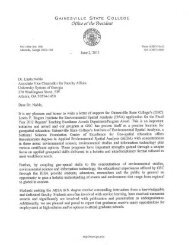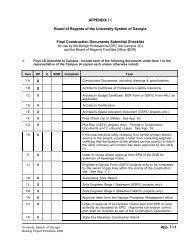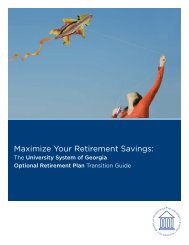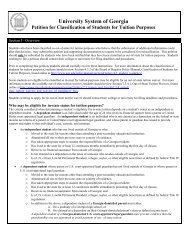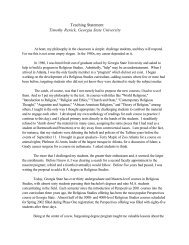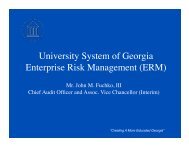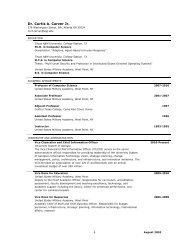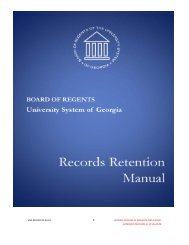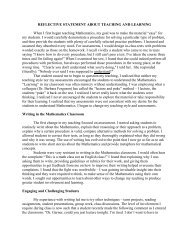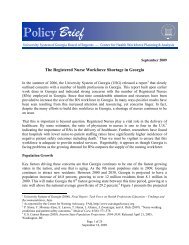WReier-Aviles on DSKGBLS3C1PROD with RULES266900 Federal Register / Vol. 75, No. 209 / Friday, October 29, 2010 / Rules and Regulationsthat institutions should use the best dataavailable in determining a student’swithdrawal date from classes.Accordingly, if an institution requiresthe taking <strong>of</strong> attendance or is requiredto take attendance for any limitedperiod <strong>of</strong> a semester or other paymentperiod, then those records should beused when determining a student’s date<strong>of</strong> withdrawal for the purposes <strong>of</strong> aReturn <strong>of</strong> Title IV Funds calculation.With respect to comments regardingthe complexity <strong>of</strong> the regulations, theyaddress the taking attendance policiesthat are either required by an outsideparty or required by the institutionitself. Institutions would already beexpected to follow these requirements,and the regulations provide for thatattendance information to be used whenit indicates a student has stoppedattending during this limited period. Forstudents in attendance at the end <strong>of</strong> thatlimited period, the guidelines fordetermining a withdrawal date for aninstitution that is not required to takeattendance would apply until the start<strong>of</strong> the next period during whichattendance taking is required. Anyincrease in overall burden is mitigatedsince this requirement is tied to policiesfor taking attendance that are already inplace at institutions, and uses theexisting requirements for determiningthe amount <strong>of</strong> Federal funds a studentearned based upon that information.Cases <strong>of</strong> noncompliance are addressedon a case by case basis when theoccurrences are isolated, andinstitutions are expected to takeappropriate corrective actions when anerror is brought to their attention duringa self-audit, a compliance audit, or aprogram review. Accordingly, the<strong>Department</strong> does not believe it isnecessary to delay the implementationdate <strong>of</strong> these regulations, or to reopenthe issue for negotiation.Changes: None.Comment: A few commentersopposed the proposed changes, arguingthat the proposed regulations exceed theSecretary’s authority under the law. Thecommenters believed that Congressintentionally allowed institutions theoption to use the midpoint <strong>of</strong> thepayment period because it recognizedthat institutions have already incurredcosts when a student fails to withdraw<strong>of</strong>ficially. A few commenters believedthat the definition <strong>of</strong> last day <strong>of</strong>attendance under the statute issufficient and that the <strong>Department</strong>should not make any changes to theregulations. Some commenters opposedthe proposal that an ‘‘institutionrequired to take attendance’’ includes aninstitution that takes attendancevoluntarily, arguing that the wording <strong>of</strong>the statute, which states ‘‘institutionsthat are required to take attendance’’ andnot ‘‘institutions that take attendance,’’indicates that Congress did not intend toinclude institutions that choose to takeattendance in that category. Othercommenters expressed strong supportfor the broadened definition.Discussion: Under the law,institutions that are required to takeattendance must use that information todetermine when students who do notcomplete a class stopped attending. It iscommon for the <strong>Department</strong> to viewrequirements established by aninstitution, such as an institutionalrefund policy, as being a requirementfor that institution. The Secretarybelieves it is reasonable to interpret thelaw to include instances where theinstitution itself is establishing therequirement to take attendance for aprogram, a department, or the entireinstitution. The regulations do notinclude instances where a facultymember would monitor studentattendance but was not required to doso by the institution. Furthermore, thereis no reason that attendance informationrequired by an institution would bedifferent in substance from attendanceinformation required by other entities. Itis the process <strong>of</strong> taking attendance itselfthat leads to the information beingavailable, regardless <strong>of</strong> whether it isrequired by the institution or an outsideentity. The law provides thatinstitutions that are required to takeattendance must use that informationfor students who stop attending, and theregulations define the term ‘‘required totake attendance’’ to include instanceswhere the institution itself isestablishing that requirement for aprogram, a subpopulation <strong>of</strong> a program,a department, or the entire institution.The Secretary also believes that thisinformation should be used when it isavailable, even if attendance is notrequired and is only taken for a limitedperiod during the payment period orperiod <strong>of</strong> enrollment.Changes: None.Comment: A number <strong>of</strong> commentersrequested clarification about whether aninstitution would be required to performa Return <strong>of</strong> Title IV Funds calculationfor students that were not in attendanceon the last day <strong>of</strong> a limited censusperiod. Specifically, a few commentersbelieved that § 668.22(b)(3)(iii)(B) couldbe interpreted in different ways. First, itcould be read to mean that aninstitution must treat a student who isnot in attendance on the last day <strong>of</strong> alimited period <strong>of</strong> attendance taking as awithdrawal, even if the studentcontinued to attend classes or wasengaged in another academically-relatedVerDate Mar2010 14:10 Oct 28, 2010 Jkt 223001 PO 00000 Frm 00070 Fmt 4701 Sfmt 4700 E:\FR\FM\29OCR2.SGM 29OCR2activity after the end <strong>of</strong> the limitedperiod. Along these lines, a fewcommenters pointed out that it could bedifficult for an institution to ascertainwhether a student actually withdrew, orwhether the student was in fact onlyabsent for a class or two. Second, itcould be read to mean that if aninstitution has attendance recordsduring a limited period, the institutionmust use those attendance records, asthe best available source <strong>of</strong> information,in determining a student’s date <strong>of</strong>withdrawal. One commenter believedthat this interpretation could require aninstitution not otherwise required totake attendance to take attendancebeyond the end <strong>of</strong> the limitedattendance period to determine if thestudent came back. The commenterfurther requested clarification aboutwhen an institution in this situationwould have to determine that thestudent actually withdrew.Three commenters provided potentialmodifications to the language related totaking attendance during a limited timeperiod. The first suggested replacing thewords ‘‘in attendance at the end <strong>of</strong> thelimited period’’ with the words ‘‘inattendance during the limited period’’ toaccount for the fact that a student mighthave attended earlier in the limitedperiod but was only absent on that lastday, perhaps due to illness or anotherlegitimate reason. The secondcommenter recommended modifyingthe words ‘‘a student in attendance’’ toread ‘‘a student determined by theinstitution to be in attendance’’ in orderto give institutions the necessaryflexibility to determine that a studentactually withdrew from all courses andwas not just absent on that particularday. The third commenter suggestedreplacing the phrase ‘‘in attendance atthe end <strong>of</strong> the limited period’’ with ‘‘inattendance at the last regularlyscheduled class meeting prior to thecensus date’’ to account for courses thatdo not meet on the last day <strong>of</strong> thelimited period.One commenter believed that the<strong>Department</strong> should require institutionsto have a limited number <strong>of</strong> hours orcredits that a student may miss withouthaving to be considered a withdrawal.Discussion: Standing alone,information that a student was absenton the last date attendance was takenduring a limited period <strong>of</strong> time is thebest evidence that the student hasceased attendance. That presumption iseasily refuted when a student has goneon to complete the payment period,since the student will have earned agrade for the class. For a student whodid not complete the class, theinstitution may determine whether there
Federal Register / Vol. 75, No. 209 / Friday, October 29, 2010 / Rules and Regulations66901WReier-Aviles on DSKGBLS3C1PROD with RULES2is evidence that the student wasacademically engaged in the class at apoint after the limited period whenattendance was taken. Unless aninstitution demonstrates that awithdrawn student who is not inattendance at the end <strong>of</strong> the limitedperiod <strong>of</strong> required attendance takingattended after the limited period, thestudent’s withdrawal date would bedetermined according to therequirements for an institution that isrequired to take attendance. That is, thestudent’s withdrawal date would be thelast date <strong>of</strong> academic attendance, asdetermined by the institution from itsattendance records. If the institutiondemonstrates that the student attendedpast the end <strong>of</strong> the limited period, thestudent’s withdrawal date is determinedin accordance with the requirements foran institution that is not required to takeattendance. So, for a student theinstitution has determined attended pastthe limited period and has un<strong>of</strong>ficiallywithdrawn, the student’s withdrawaldate is the midpoint <strong>of</strong> the paymentperiod <strong>of</strong> period <strong>of</strong> enrollment unlessthe institution uses a later date whenthe student was academically engagedin the class. The institution thereforehas the option to document a student’slast date <strong>of</strong> attendance at anacademically-related activity, but aninstitution is not required to takeattendance past the end <strong>of</strong> the limitedperiod <strong>of</strong> attendance taking.We do not interpret a requirement totake attendance in one class for a‘‘census date’’ as taking attendance forpurposes <strong>of</strong> this regulation. Forexample, some institutions have coursesthat meet only on Mondays andWednesdays, and other courses thatmeet on Tuesdays and Thursdays. Inthose cases, a ‘‘census date’’ may betaken on two different days in order toestablish attendance in both sets <strong>of</strong>courses that meet on alternate days.With respect to the suggestion that aninstitution be permitted to have a policyto establish a different procedure orpresumption for a student who is absentat the end <strong>of</strong> a limited period <strong>of</strong>attendance taking, this is addressed inpractice by having the institutiondetermine if the student participated inan academically related activity at alater point in the payment period, notby adding a regulation that otherwiseignores an absence on the last dateattendance was taken for the student.Changes: None.Comment: A few commentersbelieved that the proposed regulationswould cause a greater financial burdenfor a student who withdraws fromcourses prior to the midpoint <strong>of</strong> thesemester. A few commenters noted thatinstitutions that voluntarily maintainattendance records would now have touse those records to determine thestudent’s actual last date <strong>of</strong> attendanceinstead <strong>of</strong> using a midpoint date. In thecase <strong>of</strong> clock-hour institutions,commenters were concerned thatinstitutions would be required to use anactual last date <strong>of</strong> attendance instead <strong>of</strong>a scheduled last date <strong>of</strong> attendance. Inthese situations, a student might receivefewer funds to cover costs incurred forthe entire payment period, even if he orshe withdrew before the end <strong>of</strong> thatpayment period.Discussion: The <strong>Department</strong>recognizes that using an actual last date<strong>of</strong> attendance instead <strong>of</strong> a midpoint <strong>of</strong>the semester may require an institutionto return more unearned aid; thisoutcome, however, is equitable. Forinstitutions using credit hours that aredetermined to be required to takeattendance for all or a part <strong>of</strong> the period,the regulation may establish an earlierdate <strong>of</strong> withdrawal for a student thatstops attending during a period whenattendance is taken. This outcomeprovides a more consistent treatmentwith other institutions that haveprograms where student progress istracked by measuring clock hours, andmore closely tracks the requirements inthe law that students earn title IV fundsas they progress through a period untilthey complete more than 60 percent <strong>of</strong>the period. Institutions are responsiblefor determining the amount <strong>of</strong> title IV,HEA program assistance that a studentearned under the applicable regulations,and unearned funds for a student mustbe returned in accordance with theprocedures in § 668.22. By establishinga more accurate date a student ceasedattendance during a period whenattendance is taken, the regulation willtend to increase the amount <strong>of</strong> unearnedfunds that are used to reduce the loanamounts students received for thatperiod under § 668.22(i).Changes: None.Comment: A number <strong>of</strong> commentersfrom cosmetology schools believed thatthe proposed regulations would putsome institutions in a position <strong>of</strong> beingunable to comply with both Federal andState regulations. Specifically, theywere concerned that the proposedregulations would require institutionsthat are credit-hour institutions tobecome clock-hour institutions if theytake attendance, forcing them,depending on individual State laws, tobe out <strong>of</strong> compliance with Staterequirements that those institutions usecredit hours.Discussion: We do not agree that theseregulations create a conflict betweenFederal and State laws. Institutions thatVerDate Mar2010 14:10 Oct 28, 2010 Jkt 223001 PO 00000 Frm 00071 Fmt 4701 Sfmt 4700 E:\FR\FM\29OCR2.SGM 29OCR2use clock hours for a program for Statereporting or licensing purposes will betreated as institutions that are requiredto take attendance under this regulation,and the clock hours attended will beused to determine when a studentceased attendance. To the extent thatsuch an institution uses credit hours forits academic purposes, that institutionwill not be affected by this regulation.The requirement to determine theamount <strong>of</strong> aid a student earned beforeceasing attendance is separate from thequestion <strong>of</strong> whether that institution usescredit hours for academic purposes. Theclock hours are used to measure theamount <strong>of</strong> funds a student earned, thesame way that other institutions that arerequired to take attendance willmeasure earnings under this regulation.Changes: None.Comment: A few commenterssuggested modifications to theregulatory language that would requireinstitutions to use the best informationavailable in determining a student’swithdrawal date. Specifically, onecommenter recommended amending§ 668.22(c) to make the midpoint <strong>of</strong> thepayment period the ‘‘last resort’’ optionfor determining a student’s last date <strong>of</strong>attendance when a student un<strong>of</strong>ficiallywithdraws such that a school would berequired to use the midpoint <strong>of</strong> thepayment period only in the absence <strong>of</strong>other documentation <strong>of</strong> a student’sattendance. Another commenterrecommended that we requireinstitutions to use the best availabledata when determining a withdrawaldate instead <strong>of</strong> allowing schools that arenot required to take attendance to use adefault date <strong>of</strong> the midpoint <strong>of</strong> thepayment period <strong>of</strong> period <strong>of</strong> enrollment.The commenter believed that using thislanguage would best support the<strong>Department</strong>’s goals.Discussion: We do not believe that thesuggested modifications are supportableunder the HEA because the requirementto use attendance information is onlyapplicable for periods when attendancetaking is required. Under section484B(c)(1) <strong>of</strong> the HEA, if a student stopsattending an institution at a point whereattendance taking is not required, theinstitution uses the midpoint <strong>of</strong> thepayment period, or may use a later datewhen the student was participating inan academically related activity.Changes: None.Comment: One commenter wasconcerned that if an institution that isrequired to take attendance did not havea valid ISIR before a student’s last date<strong>of</strong> attendance, the student would beunintentionally penalized and unable toreceive title IV, HEA programassistance.
- Page 1 and 2:
Friday,October 29, 2010Part IIDepar
- Page 3 and 4:
Federal Register / Vol. 75, No. 209
- Page 6 and 7:
66836 Federal Register / Vol. 75, N
- Page 8 and 9:
66838 Federal Register / Vol. 75, N
- Page 10 and 11:
WReier-Aviles on DSKGBLS3C1PROD wit
- Page 12 and 13:
66842 Federal Register / Vol. 75, N
- Page 14 and 15:
66844 Federal Register / Vol. 75, N
- Page 16 and 17:
WReier-Aviles on DSKGBLS3C1PROD wit
- Page 18 and 19:
66848 Federal Register / Vol. 75, N
- Page 20 and 21: 66850 Federal Register / Vol. 75, N
- Page 22 and 23: WReier-Aviles on DSKGBLS3C1PROD wit
- Page 24 and 25: 66854 Federal Register / Vol. 75, N
- Page 26 and 27: WReier-Aviles on DSKGBLS3C1PROD wit
- Page 28 and 29: 66858 Federal Register / Vol. 75, N
- Page 30 and 31: 66860 Federal Register / Vol. 75, N
- Page 32 and 33: 66862 Federal Register / Vol. 75, N
- Page 34 and 35: 66864 Federal Register / Vol. 75, N
- Page 36 and 37: 66866 Federal Register / Vol. 75, N
- Page 38 and 39: WReier-Aviles on DSKGBLS3C1PROD wit
- Page 40 and 41: WReier-Aviles on DSKGBLS3C1PROD wit
- Page 42 and 43: 66872 Federal Register / Vol. 75, N
- Page 44 and 45: WReier-Aviles on DSKGBLS3C1PROD wit
- Page 46 and 47: WReier-Aviles on DSKGBLS3C1PROD wit
- Page 48 and 49: WReier-Aviles on DSKGBLS3C1PROD wit
- Page 50 and 51: 66880 Federal Register / Vol. 75, N
- Page 52 and 53: WReier-Aviles on DSKGBLS3C1PROD wit
- Page 54 and 55: 66884 Federal Register / Vol. 75, N
- Page 56 and 57: 66886 Federal Register / Vol. 75, N
- Page 58 and 59: WReier-Aviles on DSKGBLS3C1PROD wit
- Page 60 and 61: WReier-Aviles on DSKGBLS3C1PROD wit
- Page 62 and 63: WReier-Aviles on DSKGBLS3C1PROD wit
- Page 64 and 65: WReier-Aviles on DSKGBLS3C1PROD wit
- Page 66 and 67: WReier-Aviles on DSKGBLS3C1PROD wit
- Page 68 and 69: WReier-Aviles on DSKGBLS3C1PROD wit
- Page 72 and 73: 66902 Federal Register / Vol. 75, N
- Page 74 and 75: WReier-Aviles on DSKGBLS3C1PROD wit
- Page 76 and 77: WReier-Aviles on DSKGBLS3C1PROD wit
- Page 78 and 79: 66908 Federal Register / Vol. 75, N
- Page 80 and 81: WReier-Aviles on DSKGBLS3C1PROD wit
- Page 82 and 83: 66912 Federal Register / Vol. 75, N
- Page 84 and 85: WReier-Aviles on DSKGBLS3C1PROD wit
- Page 86 and 87: 66916 Federal Register / Vol. 75, N
- Page 88 and 89: WReier-Aviles on DSKGBLS3C1PROD wit
- Page 90 and 91: WReier-Aviles on DSKGBLS3C1PROD wit
- Page 92 and 93: WReier-Aviles on DSKGBLS3C1PROD wit
- Page 94 and 95: 66924 Federal Register / Vol. 75, N
- Page 96 and 97: WReier-Aviles on DSKGBLS3C1PROD wit
- Page 98 and 99: 66928 Federal Register / Vol. 75, N
- Page 100 and 101: WReier-Aviles on DSKGBLS3C1PROD wit
- Page 102 and 103: 66932 Federal Register / Vol. 75, N
- Page 104 and 105: WReier-Aviles on DSKGBLS3C1PROD wit
- Page 106 and 107: 66936 Federal Register / Vol. 75, N
- Page 108 and 109: 66938 Federal Register / Vol. 75, N
- Page 110 and 111: 66940 Federal Register / Vol. 75, N
- Page 112 and 113: 66942 Federal Register / Vol. 75, N
- Page 114 and 115: 66944 Federal Register / Vol. 75, N
- Page 116 and 117: 66946 Federal Register / Vol. 75, N
- Page 118 and 119: WReier-Aviles on DSKGBLS3C1PROD wit
- Page 120 and 121:
WReier-Aviles on DSKGBLS3C1PROD wit
- Page 122 and 123:
WReier-Aviles on DSKGBLS3C1PROD wit
- Page 124 and 125:
66954 Federal Register / Vol. 75, N
- Page 126 and 127:
WReier-Aviles on DSKGBLS3C1PROD wit
- Page 128 and 129:
66958 Federal Register / Vol. 75, N
- Page 130 and 131:
66960 Federal Register / Vol. 75, N
- Page 132 and 133:
WReier-Aviles on DSKGBLS3C1PROD wit
- Page 134 and 135:
WReier-Aviles on DSKGBLS3C1PROD wit
- Page 136 and 137:
WReier-Aviles on DSKGBLS3C1PROD wit
- Page 138 and 139:
66968 Federal Register / Vol. 75, N
- Page 140 and 141:
66970 Federal Register / Vol. 75, N
- Page 142 and 143:
66972 Federal Register / Vol. 75, N
- Page 144 and 145:
66974 Federal Register / Vol. 75, N



